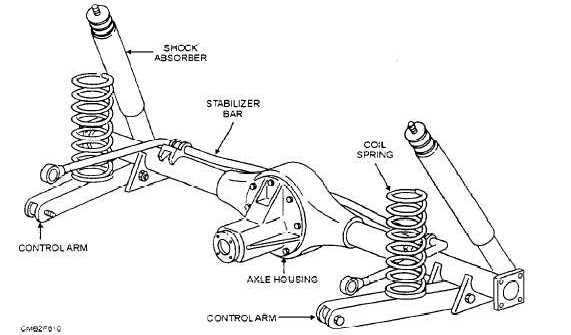shape requires less space to operate in. Pads are sometimes used between the spring and the chassis to eliminate transferring vibrations to the body. Because of its design, the coil spring cannot be used for torque reaction or absorbing side thrust. Therefore, control arms and stabilizers are required to maintain the proper geometry between the body and suspension system. This is the most common type of spring found on modern suspension systems.
Coil spring mountings are quite simple in construction. The hanger and spring seat are shaped to fit the coil ends and hold the spring in place. Cups that fit snugly on each coil end are often used for mounting. The upper cup can be formed within the frame, in the control arms, or part of a support bracket rigidly fixed to the cross member or frame rail. The lower cup is fastened to a control arm hinged to a cross member or frame rail. Rubber bumpers are included on the lower spring support to prevent metal-to-metal contact between the frame and control arm, as the limits of compression are reached.
Leaf Spring
The leaf spring acts as a flexible beam on self-propelled vehicles and transmits the driving and breaking forces to the frame from the axle assembly. Leaf springs are semi-elliptical in shape and are made of high quality alloy steel. There are two types of leaf springs - single leaf and multileaf (fig. 8-11). The single leaf spring, or monoleaf, is a single layer spring that is thick in the center and tapers down at each end. Single leaf springs are used in lighter suspension systems that do not carry great loads. A multileaf spring is made up of a single leaf with additional leaves. The additional leaves make the spring stiffer, allowing it to carry greater loads.
The most common type is the multileaf spring (fig. 8-12) that consists of a single leaf with a number of additional leaves attached to it using spring clips. Spring clips, also known as rebound clips, surround the leaves at intervals along the spring to keep the leaves from separating on the rebound after the spring has been depressed. The clips allow the springs to slide, but prevent them from separating and causing the entire rebound stress to act on the master leaf. The multileaf spring uses an insulator (frictional material) between the leaves to reduce wear and eliminate any squeaks that might develop. To keep the leaves equally spaced lengthwise, use a center bolt for the multileaf spring. The center bolt rigidly holds the leaves together in the middle of the spring, preventing the leaves from moving off center. Each end of the largest leaf is rolled into an eye, which serves as a means of attaching the spring to the vehicle. Leaf springs are attached to the vehicle using a spring hanger that is rigidly mounted to the frame in the front and the spring shackle in the rear, which allows the spring to expand and contract without binding as it moves through its arc. Bushings and pins provide the bearing or support points for the vehicle. Spring bushings may be made of bronze or rubber and are pressed into the spring eye. The pins that pass

Figure 8-10. - Coil springs.
Continue Reading